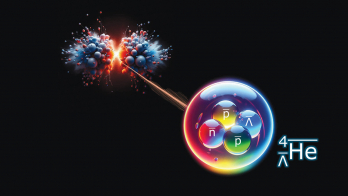
The BASE collaboration at the CERN Antiproton Decelerator (AD) has made the most precise comparison yet between the properties of matter and antimatter. Reporting in Nature in January, following a 1.5 year-long measurement campaign, the collaboration finds the charge-to-mass ratios of protons and antiprotons to be identical within an experimental uncertainty of just 16 parts per trillion. The result is four times more precise than the previous BASE comparison in 2015 and places strong constraints on possible violations of CPT invariance in the Standard Model.
The charge-to-mass ratio is now the most precisely measured property of the antiproton
Stefan Ulmer
Invariance under the simultaneous operations of charge conjugation, parity transformation and time reversal is a pillar of quantum field theories such as the Standard Model. Direct, high-precision tests of CPT invariance are therefore powerful probes of new physics, and of the possible mechanisms through which the universe came to be matter-dominated.
“The charge-to-mass ratio is now the most precisely measured property of the antiproton,” says BASE spokesperson Stefan Ulmer of RIKEN in Japan. “To reach this precision, we made considerable upgrades to the experiment and carried out the measurements when the antimatter factory was closed down, so that they would not be affected by disturbances from the experiment’s magnetic field.” The upgrades include a rigorous re-design of the cryostage of the experiment and the development of a multi-layer shielding-coil system, which considerably reduced magnetic-field fluctuations in the central measurement trap, explains Ulmer. “Another important ingredient is the implementation of a superconducting image-current detection system with tunable resonance frequency and ultra-high non-destructive detection efficiency, which eliminates the dominant systematic shift of the previous charge-to-mass ratio comparison.”
The BASE team confined antiprotons and negatively charged hydrogen ions in a state-of-the-art Penning trap, in which charged particles follow a cyclical trajectory with a frequency that scales with the trap’s magnetic-field strength and the particle’s charge-to-mass ratio.
By alternately feeding antiprotons and hydrogen ions one at a time into the trap, the team was able to measure their cyclotron frequencies under the same conditions. Performed over four campaigns between December 2017 and May 2019, the measurements involved more than 24,000 cyclotron-frequency comparisons, each lasting 260 seconds. Within the experimental uncertainty, the result, –(q/m)p/(q/m)p̄= 1.000000000003(16), demonstrates that the Standard Model respects CPT invariance at an energy scale of 1.96×10–27 GeV at 68% confidence. It also improves knowledge of 10 coefficients in the Standard Model extension – a generalised, observer-independent effective field theory used for investigations of Lorentz violation.
Weak equivalence principle
The BASE team also used their data to test the weak equivalence principle, which states that different bodies in the same gravitational field undergo the same acceleration. Any difference between the gravitational interaction of protons and antiprotons, for example due to anomalous gravitational scalar or tensor couplings to antimatter, would result in a difference in the proton and antiproton cyclotron frequencies. Sampling the varying gravitational field of Earth as it orbits the Sun, BASE found no such difference, constraining the strength of anomalous antimatter/gravitational interactions to less than 1.8×10–7 and enabling the first differential test of the weak equivalence principle (WEP) using antiprotons.
“From this interpretation we constrain the differential matter–antimatter WEP-violating coefficient to less than 0.03, which is comparable to the initial precision goals of other AD experiments that aim to drop antihydrogen in the Earth’s gravitational field,” explains Ulmer. “BASE did not directly drop antimatter, but our measurement of the influence of gravity on a baryonic antimatter particle is, according to our understanding, conceptually very similar, indicating no anomalous interaction between antimatter and gravity at the achieved level of uncertainty.”
The collaboration expects to reach even higher sensitivities on both the WEP test and the proton–antiproton charge-to- mass ratio comparison by increasing the experiment’s magnetic-field strength, stability and homogeneity. Further improvements are anticipated from the use of transportable antiproton traps, such as BASE-STEP, which allow precision antiproton experiments to be moved from the fluctuating accelerator environment to a calm laboratory space.
Further reading
BASE collaboration 2022 Nature 601 53.








